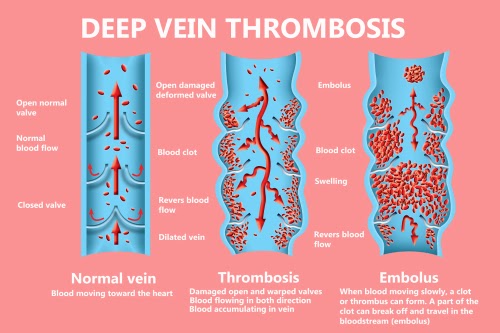Vascular health is an important topic that most people do not understand fully. This includes venous (vein) health, and the risk factors involved with blood clots (thrombosis) and other vein conditions. One of these conditions is deep vein thrombosis (DVT). DVT occurs when a part of the leg’s vein fills with blood clots. Deep vein thrombosis can become life-threatening or cause other serious health conditions. Learn more about DVT, the risk factors, and what you can do to ensure your veins are functioning correctly to prevent the condition.
What is Deep Vein Thrombosis (DVT)?
Deep vein thrombosis, DVT, is a condition where a blood clot forms in a deep vein. These clots often form in either the legs, thighs or pelvic area. These clots can cause symptoms such as pain, swelling, and redness in these areas. Blood clots can become serious if they break free and move through the bloodstream to other organs (e.g. lungs).
In rare cases, it can even cut off blood flow to your lungs. Deep vein blood clots are often found in your thigh or lower leg, but they can also develop in other areas of your body. DVT can lead to major health problems and can sometimes be fatal.
Deep vein thrombosis is a serious condition that can lead to a number of other serious health conditions, such as pulmonary embolism, stroke, heart attack, or even death.

History of DVT and How it Has Evolved Over Time
Before we get into the details of DVT and its causes, it’s important to examine how our understanding of this condition has evolved over time. When we think of blood clots and clotting in general, we typically imagine a very simple function that is regulated effectively without any issues. But the truth is that things aren’t always so easy.
Early Understandings of DVT
The first real medical reports about DVT come to us from ancient Greece. The Greeks were able to identify that this condition existed, but they had no knowledge of the root causes or mechanics behind it. Fast forward a few centuries and we see more curiosity in blood clotting; doctors began to realize that two men (brothers) who had been injured in battle were developing blood clots, but only one of the two had been seriously wounded.
At this point, doctors were well aware that certain injuries could cause coagulation to occur, but they still didn’t understand the exact mechanisms behind it. However, when looking at these cases side-by-side, their curiosity was piqued enough to start making some headway.
Recent Studies of Thrombosis
In more recent times, DVT has been at the forefront of medical research due to the many cases of it appearing in hospitalized patients. These are patients who typically have weakened immune systems and other issues that could contribute to venous clot formation. Hospital staff would study these cases and learn more about how it worked and what kind of conditions might make DVT more likely to appear.
Development of Efficient Diagnosis for DVT
In the 1980s, a number of research studies were conducted, which led to doctors being able to diagnose DVT much easier than before. This is primarily due to a new diagnostic tool developed in the early 1980s called D-dimer. D-dimer testing involves drawing blood, letting the clotting factors in the blood form clots, and then measuring the D-dimer levels in your sample. High levels of D-dimer are correlated with DVT because it means that there is a significant amount of fibrin present in your body.
Gaining an understanding of the various risk factors that can lead to DVT has also been an important aspect of modern medical research on the condition. While many cases have no known cause, a number of factors have been identified as leading to increased risks for blood clots in your veins.
Who Is At Risk for Deep Vein Thrombosis?
Certain people are more likely to develop DVT than others and varying risk factors may increase the occurrence. Risk factors are characteristics or conditions that increase your likelihood of developing a certain disease or condition.
Since DVT is hard to detect it’s good to know what puts you at risk so you can avoid getting it.
Some of these risk factors for deep vein thrombosis include:
Previous blood clots
- About 30% of people who’ve had a blood clot or DVT will have it again.
Having a family history of DVT or an inherited clotting disorder
- These are rare conditions that make it easier for clots to form in the veins.
Being 50 years of age or more
- Having one or more DVT increases with your age and is more common in people who are 50 years and older. Although, people older than 35 should still be aware of DVT.
Staying still for long periods of time
- This can happen when you are on a plane, sitting in the car, or even sitting at your desk. Make sure you take regular walking breaks to encourage healthy blood flow in your legs.
Traumatic Injuries
- Having an injury that damages your veins creates an environment where blood clots form.
Taking birth control
- Birth control pills do increase the likelihood of developing blood clots and DVT, but the risk is only the highest within the first year.
Smoking
- Regular smoking and tobacco use weakens your body’s natural healing ability, damage vein function, and harms your lungs.
Having surgery
- Surgery means that you will be under anesthesia for a long time and that may increase your chances of DVT. You are also more likely to get DVT if you have had surgery in the past.
Obesity
- People who are obese have more fatty tissue which can make it harder for your blood to flow and easier for a clot to form in the veins.
Cancer
- Having certain types of cancer can increase the likelihood of developing DVT.
Other medical conditions
- Having certain medical conditions like heart failure, heart attack, stroke, diabetes, and blood clotting disorders can also make you more likely to develop DVT.
Signs and Symptoms of DVT
Often people with DVT don’t have any symptoms. That’s why it’s even more important to know the risk factors to prevent DVT. The symptoms for DVT often mimic those of lesser vascular issues, like varicose veins.
People who do have symptoms may feel pain, swelling, or redness in the leg carrying the clot, which is very similar to other symptoms felt from circulation issues.
Symptoms of deep vein thrombosis include:
- Swelling in one or both legs
- Pain or tenderness in one or both legs, even if it’s just when you walk or stand
- Warm skin on your leg
- Red or discolored skin on your legs
- Visible veins
- Tired legs
Since DVT can become life-threatening you should see a vascular doctor if you experience any symptoms. The surgeons at The Vein Centre are all board-certified vascular surgeons and have 100 years of combined vein expertise.
Treating Deep Vein Thrombosis
Treatment of DVT depends on how severe it is and what symptoms you are having. Your doctor will determine the best course of action after evaluating your medical history, physical exam, and other tests indicating the presence of clots in veins.
Blood Thinners
Whether you have a clot and no symptoms or experience pain and other DVT symptoms, DVT is usually treated with blood-thinning medications to dissolve the clot. This will prevent more clots from forming as well as keep your existing clot from getting larger. Blood thinners can be taken by mouth or by injection to prevent clots from enlarging and reaching the heart or lungs.
Vein Surgery
Sometimes surgery may be recommended if you can’t take blood-thinning medication or if your blood-thinning medication isn’t working.
Vein Filters
Another treatment option is to place a filter in the vein. This is called an inferior vena cava filter and it may be placed in your body if you have a blood clot that’s unlikely to dissolve. While this won’t stop DVT from forming, it can help keep existing clots from moving through the veins to the lungs where they can cause serious problems.
Prevention Strategies
Of course, the best way to prevent DVT is to know your risk factors and avoid activities that put you at higher risk, such as being sedentary for long periods of time.
Some ways you can prevent DVT include:
- Walking around every 2 hours when on a plane or in a car for a long time.
- Not crossing your legs and making sure to get up from your desk every hour or so during the workday.
- Not smoking tobacco.
- Checking with your doctor before taking a plane trip if you have a heart condition, leg injury, lung disease, or joint replacement. These things can increase your risk of developing blood clots.
- Wearing compression stockings if the doctor recommends it.
- Talk to your doctor about a prophylactic treatment if you have a higher risk of developing DVT from surgery, being immobile for long periods of time, or having certain medical conditions that put you at high risk for blood clots.
Schedule An Appointment for DVT
The vascular surgeons at The Vein Centre know the anatomy of deep vein thrombosis and are best suited to treat it.
If you are concerned about the risk of developing deep vein thrombosis, please call us today at 615.269.9007. We have clinics in Belle Meade and Mt. Juliet, Tennessee to help anyone who is worried about their risks for venous diseases like DVT.



